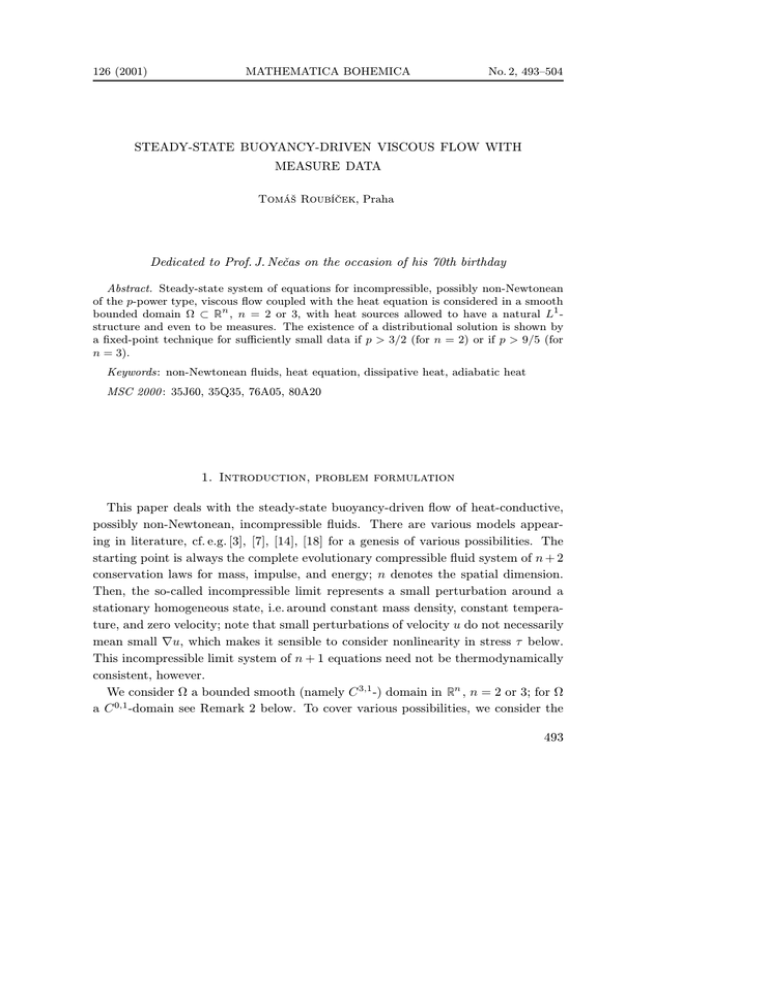STEADY-STATE BUOYANCY-DRIVEN VISCOUS FLOW WITH MEASURE DATA
advertisement

126 (2001)
MATHEMATICA BOHEMICA
No. 2, 493–504
STEADY-STATE BUOYANCY-DRIVEN VISCOUS FLOW WITH
MEASURE DATA
Tomáš Roubíček, Praha
Dedicated to Prof. J. Nečas on the occasion of his 70th birthday
Abstract. Steady-state system of equations for incompressible, possibly non-Newtonean
of the p-power type, viscous flow coupled with the heat equation is considered in a smooth
bounded domain Ω ⊂ Ên , n = 2 or 3, with heat sources allowed to have a natural L1 structure and even to be measures. The existence of a distributional solution is shown by
a fixed-point technique for sufficiently small data if p > 3/2 (for n = 2) or if p > 9/5 (for
n = 3).
Keywords: non-Newtonean fluids, heat equation, dissipative heat, adiabatic heat
MSC 2000 : 35J60, 35Q35, 76A05, 80A20
1. Introduction, problem formulation
This paper deals with the steady-state buoyancy-driven flow of heat-conductive,
possibly non-Newtonean, incompressible fluids. There are various models appearing in literature, cf. e.g. [3], [7], [14], [18] for a genesis of various possibilities. The
starting point is always the complete evolutionary compressible fluid system of n + 2
conservation laws for mass, impulse, and energy; n denotes the spatial dimension.
Then, the so-called incompressible limit represents a small perturbation around a
stationary homogeneous state, i.e. around constant mass density, constant temperature, and zero velocity; note that small perturbations of velocity u do not necessarily
mean small ∇u, which makes it sensible to consider nonlinearity in stress τ below.
This incompressible limit system of n + 1 equations need not be thermodynamically
consistent, however.
We consider Ω a bounded smooth (namely C 3,1 -) domain in Ên , n = 2 or 3; for Ω
a C 0,1 -domain see Remark 2 below. To cover various possibilities, we consider the
493
following fairly general system of equations:
(1.1a) (u · ∇)u − div τ (e(∇u)) + ∇π = g(1 − α0 θ),
div u = 0,
(1.1b)
(1.1c)
where [τij ] : [eij ] =
e(∇u) =
1
1
∇u + (∇u)T
2
2
u · ∇θ − κ∆θ = α1 τ (e(∇u)) : e(∇u) + α2 θg · u + h,
n n
i=1 j=1
τij eij , κ is the heat conductivity, α0 is the linearized rel-
ative mass density variation with respect to temperature, α1 reflects the dissipation
effects, α2 expresses the adiabatic heat effects, τ (e) is the viscous stress, g an external (e.g. gravitational or centrifugal) force, and h = h(x) is the external heat source.
For simplicity of notation, we normalize the mass density and the heat capacity to 1.
For a rigorous derivation of a system like (1.1) in the evolution case, we refer
to Kagei, Růžička and Thäter [7, System (16)] who showed how the coefficient α1
depends on Ostrach’s dissipation number, while the coefficient α2 depends also on
the Reynolds and the Prandtl numbers.
The system should be completed by boundary conditions. For simplicity, we will
consider a no-slip boundary condition for velocity and the Newton condition with
prescribed heat flux f for temperature, i.e.
(1.2)
u = 0,
κ
∂θ
+ bθ = f
∂ν
on Γ,
with ν denoting the unit normal to the boundary ∂Ω =: Γ of Ω and b denoting the
coefficient of the heat transfer through Γ.
Often a simpler, so-called Oberbeck-Boussinesq model is used for the buoyancydriven flow of heat-conductive incompressible fluids. This model neglects both the
dissipative and the adiabatic heat sources, i.e. α1 = α2 = 0, and usually considers
τ (e) = e which turns (1.1a,b) into the Navier-Stokes system, cf. e.g. Gebhart et al. [5]
or Rajagopal et al. [18], and sometimes it is combined with other phenomena as
solidification, see Rodriguez [19]. For a non-Newtonean model coupled with the
heat equation we refer to Málek at al. [13] and to Rodriguez and Urbano [20] who
allowed the viscosity to depend also on temperature. Temperature dependence of the
viscosity tensor τ was investigated also by Baranger and Mikelić [2] for the special
case α1 = 1, α0 = 0 (i.e. no buoyancy) and α2 = 0, which makes the situation quite
different from the buoyancy driven flow. Besides, some buoyancy-driven models
include the dissipative heat but not the adiabatic heat sources (i.e. our model (1.1)
with α1 > 0 but α2 = 0), cf. Landau and Lifshitz [9, Sect. 50] or also, e.g., Kagei [6]
or Moseenkov [14].
494
The measures as heat sources for the buoyancy-driven flow have been investigated
for b = 0 and f = 0 in [16] in the evolutionary case, which differs from the steadystate case both factually (existence of a non-negative solution holds for arbitrarily
large data) and technically (L1 -accretivity for the heat equation can be used instead
of mere W 2,2 -regularity and interpolation with transposition).
2. Distributional solution to (1.1)–(1.2)
We want to treat the system (1.1) in as much general as possible (but still physical)
situations. The heat transfer (1.1c) has a natural L1 -structure, which encourages us
to consider the heat sources h ∈ L1 (Ω) and f ∈ L1 (Γ), or even as measures. Then
the concept of a weak solution is no longer relevant, and one must speak in terms
of distributional solutions, using transposition and W 2,2 -regularity with Hilbertianspace interpolation of the adjoint to the left-hand-side linear operator in (1.1c).
We use the following standard notation for functions spaces: Lp (Ω; Ên ) denotes
the Lebesgue space of measurable functions Ω → Ên whose p-power is integrable,
W01,p (Ω; Ên ) is the Sobolev space of functions whose gradient is in Lp (Ω; Ên×n ) and
1,p
(Ω; Ên ) = {v ∈ W 1,p (Ω; Ên ); div v = 0 in the
whose trace on Γ vanishes, W0,DIV
1,p
sense of distributions}, and W −1,p (Ω; Ên ) ∼
= W0 (Ω; Ên )∗ with p denoting the
conjugate exponent, i.e. p = p/(p − 1). Likewise, W k,p indicates all kth derivatives
belonging to the Lp space; for k noninteger it refers to a fractional derivative and
W k,p then denotes the Sobolev-Slobodetskiı̆ space. Let us agree to use the norm
uW 1,p (Ω;Ên) := ∇uLp(Ω;Ên×n) . Also, “rca” will denote the regular countably
0
additive set functions with respect to a Borel σ-algebra in question, also called Radon
measures.
We will assume the following data qualification:
3n
(2.1a) τ has a C 2 -potential, τ (e) : e ζ1 |e|p , |τ (e)| c(|e|p−1 + 1), p >
,
n+2
ζ1 |e1 − e2 |p + ζ2 |e1 − e2 |2 if p 2
(2.1b)
(τ (e1 ) − τ (e2 )) : (e1 − e2 ) ζ0 (|e1 | + |e2 |)p−2 |e1 − e2 |2 if p < 2,
n
ζ3 (1 + |e|p−2 )|ξ|2 if p 2
∂τij
(2.1c)
ξij ξkl ∂ekl
ζ3 |e|p−2 |ξ|2 if p < 2,
i,j,k,l=1
(2.1d)
(2.1e)
h ∈ rca(Ω), f ∈ rca(Γ), g ∈ L∞ (Ω; Ên ), b ∈ C 0,1 (Γ),
κ > 0, α0 , α1 , α2 0, b(x) b0 > 0,
495
with ζi > 0, i = 0, . . . , 3. An example of τ satisfying (2.1a–c) is τ (e) = (1 + |e|p−2 )e
(if p 2) or τ (e) = |e|p−2 e (if p 2). Let us also recall that (2.1a–c) ensures
(2.2a)
Ω
(2.2b)
Ω
τ (e(∇u)) : ∇u dx c1 upW 1,p (Ω;Ên)
0
(τ (e(∇u1 )) − τ (e(∇u2 ))) : e(∇u1 − ∇q2 ) dx
ζ1 c1,Ω u1 − u2 pW 1,p (Ω;Ên) + ζ2 c2,Ω u1 − u2 2W 1,2 (Ω;Ên) if p 2
0
ζ0 c0,Ω (u1 W 1,p (Ω;Ên) + u2 W 1,p (Ω;Ên) )u1 − u2 2W 1,p (Ω;Ên) if p < 2,
0
0
0
with some ci,Ω > 0 resulting from Korn’s inequality, c0,Ω (·) decreasing; cf. [12,
Sect 5.1.2]. Let us also introduce an exponent q by
2p
q
p−1
(2.3)
<
pn
n−p
if p < n
< +∞ otherwise,
which ensures, in particular, the compact embedding W01,p (Ω; Ên ) ⊂ Lq (Ω; Ên ). By
using Green’s formula once for (1.1a,b) and twice for (1.1c), one gets the following
definition:
1,p
(Ω; Ên ) × W r,2 (Ω), with r ∈ [0, 1] satisDefinition. We will call (u, θ) ∈ W0,DIV
fying
4−n
2n − 2p − pn
<r<
,
2p
2
(2.4)
a distributional solution to (1.1)–(1.2) if
(2.5)
Ω
((u · ∇)u) · v + τ (e(∇u)) : e(∇v) − g · v(1 − α0 θ) dx = 0
for any v ∈ W01,p (Ω; Ên ), and
(2.6)
Ω
((u · (∇v + α2 gv) + κ∆v)θ + α1 τ (e(∇u)) : e(∇u)v dx
+
vh( dx) + vf ( dS) = 0
Ω
Γ
∂
for any v smooth with κ ∂ν
v + bv = 0 on Γ.
Note that (2.1) ensures that r ∈ [0, 1] satisfying (2.4) does exist (recall that n 3);
in other words, (2.4) brings no restriction on p if n 3, as assumed. Let us remark
that the inequalities in (2.4) imply respectively W r,2 (Ω) ⊂ Lq (Ω) and W 2−r,2 (Ω) ⊂
496
C(Ω); of course, q := q/(q − 1). Also, (2.1) implies that all integrals in (2.2)–(2.6)
have good sense. Also note that (2.1a) indeed enables us to choose q such that
p−1 + 2q −1 1, see (2.3), which implies that, e.g., the expression like |v|2 ∇v is
integrable for any v ∈ W 1,p (Ω).
3. Existence of the distributional solution
We will prove the existence nonconstructively by using the Schauder fixed point
theorem. First, we define the mapping
A : ϑ → u : Lq (Ω) → W01,p (Ω; Ên )
(3.1)
by u being the weak solution to
(3.2)
(u · ∇)u − div τ (e(∇u)) + ∇π = g(1 − α0 ϑ),
div u = 0,
u|Γ = 0.
For q < pn/(n − p), let us agree to denote by Nq1,p the norm of the embedding
W01,p (Ω; Ên ) ⊂ Lq (Ω; Ên ).
Lemma 1. Assume (2.1). Then there is R = R(p, Ω, c, ζ0 , . . . , ζ2 ) > 0 such that A
is single-valued and (weak,norm)-continuous with respect to the topologies indicated
in (3.1) on the set
SR := {ϑ ∈ Lq (Ω); g(1 − α0 ϑ)Lq (Ω;Ên) < R}.
(3.3)
.
Take ϑk ϑ in Lq (Ω), which implies ϑk → ϑ in W −1,p (Ω) because
Lq (Ω) ⊂ W −1,p (Ω) compactly, cf. (2.3). Then denote by uk the weak solution to
(3.2) corresponding to ϑk in place of ϑ; for the existence of uk we refer to Lions [10,
Ch. II, Remark 5.5] after a modification to τ depending on e(∇u) instead of ∇u or,
even for p 2n/(n + 1), also Frehse, Málek and Steinhauer [4] or Růžička [22]. By
testing with uk , we get in a standard way the a-priori estimate
(3.4)
p−1
uk W
1,p
(Ω;Ên)
0
Nq1,p
Nq1,p R
g(1 − α0 ϑk )Lq (Ω;Ên) <
=: R0p−1 .
ζ1
ζ1
Taking a weakly convergent subsequence in W01,p (Ω; Ên ), it is a standard procedure
to show that its limit, denote it by u, is a weak solution to (3.2), cf. again [4], [10],
[22].
497
Let us now prove uniqueness of u provided ϑ ∈ SR from (3.3) with R small
enough. Take two weak solutions u1 , u2 of (3.2), and test the difference of the weak
formulation of (3.2) by u12 := u1 − u2 . This gives
(3.5)
cu12 2W 1,min(2,p) (Ω;
0
Ên) Ω
(τ (e(∇u1 )) − τ (e(∇u2 )) : e(∇u12 ) dx
((u2 · ∇)u2 − (u1 · ∇)u1 ) · u12 dx
12
2
12
= − ((u · ∇)u ) · u dx − ((u1 · ∇)u12 ) · u12 dx
=
Ω
Ω
Ω
∇u2 Lp (Ω;Ên×n) u12 2L2p (Ω;Ên) R0 u12 2L2p (Ω;Ên)
with c = ζ2 c2,Ω (if p 2) or c = ζ0 c0,Ω (2R0 ) (if p < 2). Then, if R is small enough
1,min(2,p) −2
) , we get u12 = 0. This, together with (3.4),
so that, by (3.4), R0 < c(N2p
gives the bound in (3.3).
Having the uniqueness of u, we can conclude that even the whole sequence {uk }
converges weakly to u. Let us prove the strong convergence: subtracting (3.2) with
u and uk , testing by uk − u, and using Korn’s inequality (2.2), we get
(3.6)
max(2,p)
εuk − uW 1,p (Ω;Ên) (τ (e(∇uk )) − τ (e(∇u)) : e(∇uk − ∇u) dx
0
Ω
= ((uk · ∇)uk − (u · ∇)u) · (uk − u) + α0 (ϑk − ϑ)g · (uk − u) dx
Ω
=: I1k + I2k
with ε = ζ1 c1,Ω (if p 2) or ε = ζ0 c0,Ω (2R0 ) (if p < 2). By using div uk = 0 =div u
and Green’s formula, we can calculate
(3.7)
I1k =
n
n Ω j=1
n
=
i=1
Ω i,j=1
=−
Ω
∂ k ∂ k
uj −
uj (uj − uj ) dx
ui
∂xi
∂xi
i=1
n
∂
(uk uk − ui uj )(ukj − uj ) dx
∂xi i j
Ω i,j=1
n
=−
uki
(uki ukj − ui uj )
∂
(uk − uj ) dx
∂xi j
(uk ⊗ uk − u ⊗ u) : ∇(uk − u) dx.
Due to the boundedness of ∇(uk − u) in Lp (Ω; Ên×n ), the compact embedding
W 1,p (Ω) ⊂ Lq (Ω) with p−1 + 2q −1 1, and the continuity of the Nemytskiı̆ mapping
498
u → u ⊗ u : Lq (Ω; Ên ) → Lq/2 (Ω; Ên×n ), we have uk ⊗ uk → u ⊗ u in Lq/2 (Ω; Ên×n ),
and eventually we get I1k → 0.
Also, the term I2k converges to zero because ϑk → ϑ in W −1,p (Ω) and uk u in
W01,p (Ω; Ên ).
Furthermore, let us consider the Nemytskiı̆-type mapping N : W01,p (Ω; Ên ) ×
Lq (Ω) → rca(Ω) defined by
N : (u, ϑ) → h1 = α1 τ (e(∇u)) : e(∇u) + α2 g · uϑ + h,
(3.8)
1,p
(Ω; Ên ), the linear operator
and, for u ∈ W0,DIV
Bu : (h1 , f ) → θ : rca(Ω) × rca(Γ) → W r,2 (Ω)
(3.9)
with θ being the distributional solution to
u · ∇θ − κ∆θ = h1 on Ω,
(3.10)
κ
∂θ
+ bθ = f on Γ,
∂ν
i.e. θ ∈ W r,2 (Ω) satisfies the identity
(3.11)
Ω
(u · ∇v + κ∆v)θ dx +
Ω
vh1 ( dx) +
vf ( dS) = 0
Γ
∂
v + bv = 0 on Γ.
for any v smooth with κ ∂ν
Lemma 2. Let (2.1) be valid. Then the mappings N and Bu are well defined and
1,p
(Ω; Ên ) ×
both N : W01,p (Ω; Ên ) × Lq (Ω) → rca(Ω) and (u, h1 ) → Bu (h1 , f ) : W0,DIV
rca(Ω) → Lq (Ω) are (norm×weak*,weak*)-continuous.
.
By the classical result about Nemytskiı̆ mappings, N0 : (ξ, ϑ) →
α1 τ (e(ξ)) : e(ξ) + α2 g · uϑ : Lp (Ω; Ên×n ) × Lq (Ω) → L1 (Ω) is continuous, so that
N = (N0 ◦ ∇) + h is continuous, as claimed.
Let us consider the weak solution to the auxiliary linear problem
−u · ∇v − κ∆v = ξ on Ω,
(3.12)
κ
∂v
+ bv = 0 on Γ.
∂ν
The existence of v can be proved by the standard energy method by testing (3.12)
by v; note that
(3.13)
1
(u · ∇v)v dx =
2
Ω
1
u · ∇v dx = −
2
Ω
2
(div u)v 2 dx = 0
Ω
499
so that we have the estimate vW 1,2 (Ω) K1 ξW 1,2 (Ω)∗ independent of u. Moreover, we have also the estimate
Ω
(u · ∇v)∆v dx uLq (Ω;Ên) ∇vL2q/(q−2) (Ω;Ên) ∆vL2 (Ω)
1−λ
uLq (Ω;Ên) ∇vλL2 (Ω;Ên) ∇vL
6 (Ω;Ên) ∆vL2 (Ω)
(3.14)
2−λ
Nq1,p ∇uLp(Ω;Ên×n) K1λ (N21,2 )λ ξλL2 (Ω) (K0 N61,2 )1−λ ∆vL
2 (Ω)
for λ ∈ (0, 1) such that λ 12 + (1 − λ) 16 = q−2
2q which certainly does exist for p > 3/2,
and where the constant K0 comes from the standard Laplace-operator regularity
∂v
vW 2,2 (Ω) K0 ∆vL2 (Ω) with the boundary condition κ ∂ν
+ bv = 0 with b ∈
0,1
3,1
C (Γ) on the C -domain Ω; see Nečas [15]. Then, multiplying (3.12) by ∆v and
integrating over Ω, we get the estimate
κ
Ω
|∆v|2 dx = −
Ω
(ξ + u · ∇v)∆v dx ξL2 (Ω) ∆vL2 (Ω)
+ Nq1,p uW 1,p (Ω;Ên) K1λ (N21,2 )λ ξλL2 (Ω) (K0 N61,2 )1−λ ∆v2−λ
L2 (Ω) .
(3.15)
0
Thus we can see that, if ξ ∈ L2 (Ω), ∆v is bounded in L2 (Ω). Then, using again the
Laplace-operator regularity, we get vW 2,2 (Ω) Ku ξL2 (Ω) with Ku > 0 depending
on uW 1,p (Ω;Ên) continuously and increasingly. It is important that this regularity
0,DIV
1,p
estimate holds uniformly for u ranging over bounded sets in W0,DIV
(Ω; Ên ).
The interpolation between the linear mappings ξ → v : W 1,2 (Ω)∗ → W 1,2 (Ω)
and L2 (Ω) → W 2,2 (Ω) gives a mapping W r,2 (Ω)∗ → W 2−r,2 (Ω) and an estimate
vW 2−r,2 (Ω) Ku1−r K1r ξW r,2 (Ω)∗ .
Let us rewrite the identity (3.11) into the form Bu v, θ + F, v = 0 where Bu :
W 2−r,2 (Ω) → W r,2 (Ω)∗ and F ∈ W 2−r,2 (Ω)∗ are defined by
(3.16)
Bu v := u · ∇v + κ∆v,
F, v =
Ω
v h1 ( dx) +
v f ( dS),
Γ
∼ W r,2 (Ω) is a solution
respectively. Then θ = −(Bu∗ )−1 F = −F ◦ Bu−1 ∈ W r,2 (Ω)∗∗ =
to Bu v, θ+F, v = 0. Moreover, because of surjectivity of Bu , this solution must be
unique. Also, we have the estimate θW r,2 (Ω) Ku1−r K1r F W 2−r,2 (Ω)∗ independent
of u.
Then we choose 0 r 1 so small that W 2−r,2 (Ω) ⊂ C(Ω), i.e. r < (4 − n)/2,
cf. (2.4). This eventually gives the estimate
2−r,2 1−r r
(3.17) θW r,2 (Ω) Ku1−r K1r F W 2−r,2 (Ω)∗ N∞
Ku K1 (h1 , f )rca(Ω)×rca(Γ)
500
2−r,2
with N∞
the norm of the embedding W 2−r,2 (Ω) ⊂ L∞ (Ω); note that (h1 , f ) →
F : rca(Ω) × rca(Γ) → W 2−r,2 (Ω)∗ defined by (3.16) is the adjoint mapping to v →
(v, v|Γ ) : W 2−r,2 (Ω) → C(Ω) × C(Γ).
To prove continuity of (u, h1 ) → Bu (h1 , f ), let us take h1,k → h1 in rca(Ω) weakly*
and uk → u in W 1,p (Ω; Ên ), and denote by θk the distributional solution to (3.10)
corresponding to uk and h1,k in place of u and h1 , respectively. We showed that θk
does exist and is bounded in W r,2 (Ω); realize that {∇uk } is bounded in Lp (Ω; Ên×n ).
Then, by Banach-Alaoglu-Bourbaki theorem, we can assume that, possibly up to a
subsequence,
θk → θ
(3.18)
weakly in W r,2 (Ω).
Then we can make the limit passage in the integral identity (3.11), which reads here
(3.19)
Ω
k
k
(u · ∇v + κ∆v)θ dx +
Ω
vh1,k ( dx) +
vf ( dS) = 0.
Γ
Note that certainly the term θk uk converges to θu (even strongly) because, as a
consequence of (3.18), {θk } converges strongly in W −1,p (Ω) and {uk } also strongly
in W01,p (Ω; Ên ). Thus θ = Bu (h, f ) and even the whole sequence {θk } converges
because of the already proved uniqueness of θ.
Furthermore, for > 0, we denote the ball of the radius in Lq (Ω) by
(3.20)
B := {ϑ ∈ Lq (Ω); ϑLq (Ω) }.
Proposition 1. Let (2.1) be fulfilled and let gL∞ (Ω;Ên) be sufficiently small
with respect to the other data α0 , α1 , α2 , hrca(Ω) and f rca(Γ) . Then (1.1)–(1.2)
has at least one distributional solution (u, θ).
.
(3.21)
We will investigate the mapping C : Lq (Ω) → Lq (Ω) defined by
C(ϑ) := BA(ϑ) (N (A(ϑ), ϑ), f ).
Note that any fixed point θ of C satisfies θ = Bu (h, f ) with h = N (u, θ), where
u = A(θ), which just means that the pair (u, θ) is the distributional solution to
(1.1)–(1.2). We will show that
(3.22)
B ⊂ S R
and
C(B ) ⊂ B
provided is chosen appropriately and g is small enough. Obviously, (u, θ) =
(A(ϑ), C(ϑ)) solves the decoupled system (3.2) and (3.10) with u = A(ϑ) and h1 =
501
hu,ϑ = N (u, ϑ). Then, by testing (3.2) by u, we get the estimate (3.4) with the
subscript k omitted.
Furthermore, using the identity Ω τ (e(∇u)) : e(∇u) dx = Ω g(1 − α0 ϑ)u dx the
source term hu,ϑ in (3.10) can be estimated as
hu,ϑ rca(Ω) α1 guL1(Ω) + |α0 α1 − α2 |g · uϑL1 (Ω) + hrca(Ω)
(α1 N11,p + |α0 α1 − α2 |Nq1,p ϑLq (Ω) )gL∞ (Ω;Ên) uW 1,p (Ω;Ên)
(3.23)
+ hrca(Ω) γ1 + γ2 (gL∞ (Ω;Ên) )p ,
1/(p−1)
1/(p−1)
where we assume ϑ ∈ B and take into account that R0 = gL∞ (Ω;Ên) O(ϑLq (Ω) ),
cf. (3.4); then γ1 = γ1 (α1 , c, p, hrca(Ω) ) and γ2 (·) depends on α0 , α2 , p, and ζ1 and
moreover lim γ2 (a) = 0.
a→0+
The estimate (3.17) now reads
2−r,2 1−r r
Ku K1 (hu,ϑ rca(Ω) + f rca(Γ) ).
Bu (hu,ϑ , f )W r,2 (Ω) N∞
Altogether,
(3.24)
C(ϑ)Lq (Ω) Nqr,2
C(ϑ)W r,2 (Ω)
2−r,2 1−r r
Nqr,2
Ku K1 (γ1 + γ2 (gL∞ (Ω;Ên) )p + f rca(Γ) ).
N∞
2−r,2 1−r r
If g is small, one can find > Nqr,2
Ku K1 (γ1 + f rca(Γ) ) small enough so
N∞
that (3.24) implies C(ϑ)Lq (Ω) . In other words, we have proved C(B ) ⊂ B
for such . Moreover, if g is small enough, we have also B ⊂ SR .
We endow B with the weak (or, if q = +∞, weak*) topology of Lq (Ω), which
makes B compact (note that, due to (2.3), always q > 1). By Lemmas 1 and 2
and by (3.22), C maps B (weak,weak)-continuously into itself. Then, by Schauder’s
theorem, it has a fixed point θ on B .
1.
The interpolation/transposition method in Hilbert-space setting
was thoroughly presented by Lions and Magenes [11]. Here, however, we did not
assume infinitely smooth Γ or the coefficients u and b in (3.12) and, moreover, it
was important to derive the estimate (3.17) uniformly for u from bounded sets in
1,p
W0,DIV
(Ω; Ên ).
2. Under a quite restrictive assumption p > 2n, we can alternatively
∂
use a continuous imbedding of W := {v ∈ W 1,2 (Ω); ∆v ∈ Ln/2+ε (Ω), ∂ν
v ∈
n−1+ε
0
(Γ)} with ε > 0 into C (Ω), proved by Alibert and Raymond [1] even for
L
Lipschitz domains. Indeed, for u ∈ W 1,p (Ω; Ên ) ⊂ Lq (Ω; Ên ) with q satisfying
(2.3) and for v ∈ W 1,2 (Ω), we have u · ∇v ∈ Ln/2+ε (Ω), which enables us to
502
get the auxiliary mapping ξ → v : Ln/2+ε (Ω) → W in the proof of Lemma 1.
Then Bu : W → Ln/2+ε (Ω) and all above considerations work equally for θ in
Ln/(n−2)−ε (Ω) instead of W r,2 (Ω). Beside the C 0,1 -domain Ω, this modification
enables us also to consider b from L4/3+ε (Γ) (if n = 2) or from L6+ε (Γ) (if n = 3)
because then bv ∈ Ln−1+ε (Γ) for any v ∈ W 1,2 (Ω).
3.
Contrary to the evolution case (cf. [16]), if α2 > 0, it does not
seem possible to prove θ 0 for some solution obtained in Proposition 1 even if one
assumes h 0 and f 0. Yet, negative temperature need not be interpreted as
non-physical solution because θ is a “small” deviation from some constant reference
temperature rather than the absolute temperature. Nevertheless, this holds true if
the adiabatic effect can be neglected, i.e. α2 = 0. Then, assuming h 0 and f 0
and regularizing (1.1c) by a term εθ on the left-hand side, we can prove existence of
the “regularized” solution (uε , θε ) again by Proposition 1 with all estimates independent of ε > 0 and then nonnegativity θε 0 by testing εθε +uε ·∇θε −κ∆θε = h1 0
by signum(θε )− 1 or, more rigorously, by a regularization of this test function. Then,
passing with ε → 0, one gets θ 0.
. This research has been partly supported by the grants
201/00/0768 (GA ČR), A 107 5005 (GA AV ČR), and MSM 11320007 (MŠMT ČR).
Special thanks are due to Josef Málek and Milan Pokorný for helpful discussions,
in particular about (3.14). This paper is based on a talk presented on Professor
Jindřich Nečas’ 70th anniversary conference in Olomouc, 1999.
References
[1] Alibert, J. J., Raymond, J. P.: Boundary control of semilinear elliptic equations with
discontinuous leading coefficients and unbounded controls. Numer. Funct. Anal. Optim.
18 (1997), 235–250.
[2] Baranger, J., Mikelič, A.: Stationary solutions to a quasi-Newtonean flow with viscous
heating. Math. Models Methods Appl. Sci. 5 (1995), 725–738.
[3] Bayly, B. J., Levermore, C. D., Passot T.: Density variations in weakly compressible
flows. Phys. Fluids A 4 (1992), 945–954.
[4] Frehse, J., Málek, J., Steinhauer, M.: An existence result for fluids with shear dependent
viscosity-steady flows. Nonlinear Anal., Theory Methods Appl. 30 (1997), 3041–3049.
[5] Gebhart, B., Jaluria, Y., Mahajan, R. L., Sammakia, B.: Buoyancy-Induced Flows and
Transport. Hemisphere Publ., Washington, 1988.
[6] Kagei, Y.: Attractors for two-dimensional equations of thermal convection in the presence of the dissipation function. Hiroshima Math. J. 25 (1995), 251–311.
[7] Kagei, Y., Růžička, M., Thäter, G.: Natural convection with dissipative heating. To
appear in Comm. Math. Physics.
[8] Kaplický, P., Málek, J., Stará, J.: C 1,α -solutions to a class of nonlinear fluids in two
dimensions-stationary Dirichlet problem. Zapisky nauchnych seminarov POMI (Sankt
Peterburg) 259 (1999), 89–121.
503
[9] Landau, L. D., Lifshitz, E. M.: Fluid Mechanics. Pergamon Press, London, 1959.
[10] Lions, J. L.: Quelques méthodes de résolution des problémes aux limites non linéaires.
Dunod, Paris, 1969.
[11] Lions, J. L., Magenes, E.: Problèmes aux limites non homogènes. Dunod, Paris, 1968.
[12] Málek, J., Nečas, J., Rokyta, M., Růžička, M.: Weak and Measure-Valued Solutions to
the Evolutionary PDE’s. Chapman & Hall, London, 1996.
[13] Málek, J., Růžička, M., Thäter, G.: Fractal dimension, attractors and Boussinesq approximation in three dimensions. Act. Appl. Math. 37 (1994), 83–98.
[14] Moseenkov, V. B.: Kachestvenyje metody issledovaniya zadach konvekciı̆ slabo szhimaemoı̆ zhidkosti. Inst. Mat. NAN Ukraı̈ni, Kiı̈v, 1998.
[15] Nečas, J.: Les méthodes directes dans la théorie des équations elliptiques. Academia,
Prague, 1967.
[16] Nečas, J., Roubíček, T.: Buoyancy-driven viscous flow with L1 -data. To appear in Nonlinear Anal., Theory Methods Appl.
[17] Rabinowitz, P.: Existence and nonuniqueness of rectangular solutions of the Bénard
problems. Arch. Rational Mech. Anal. 29 (1968), 32–57.
[18] Rajagopal, K. R., Růžička, M., Srinivasa, A. R.: On the Oberbeck-Boussinesq Approximation. Math. Models Methods Appl. Sci. 6 (1996), 1157–1167.
[19] Rodriguez, J. F.: A steady-state Boussinesq-Stefan problem with continuous extraction.
Annali Mat. Pura Appl. IV 144 (1986), 203–218.
[20] Rodriguez, J. F., Urbano, J. M.: On a three-dimensional convective Stefan problem for
a non-Newtonian fluid. Nonlinear Applied Analysis (A. Sequiera et al., eds.). Plenum
Press, 1999, pp. 457–468.
[21] Roubíček, T.: Nonlinear heat equation with L1 -data. Nonlinear Diff. Eq. Appl. 5 (1998),
517–527.
[22] Růžička, M.: A note on steady flow fluids with shear dependent viscosity. Nonlinear
Anal., Theory Methods Appl. 30 (1997), 3029–3039.
[23] Turcotte, D. L., Hsui, A. T., Torrance, K. E., Schubert, G.: Influence of viscous dissipation on Bénard convection. J. Fluid Mech. 64 (1974), 369–374.
Authors’ address: Tomáš Roubíček, Mathematical Institute, Charles University,
Sokolovská 83, CZ-186 75 Praha 8, e-mail: roubicek@karlin.mff.cuni.cz, and Institute
of Information Theory and Automation, Academy of Sciences, Pod vodárenskou věží 4,
CZ-182 08 Praha 8, Czech Republic.
504





